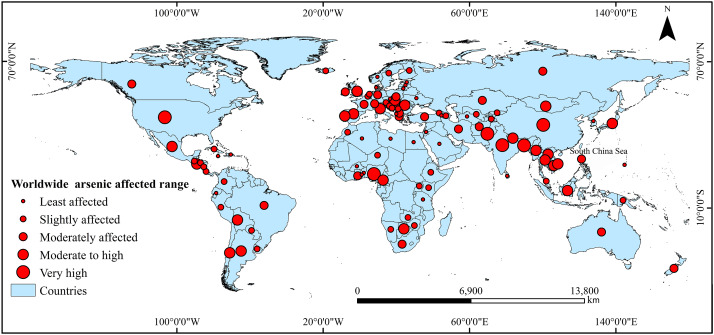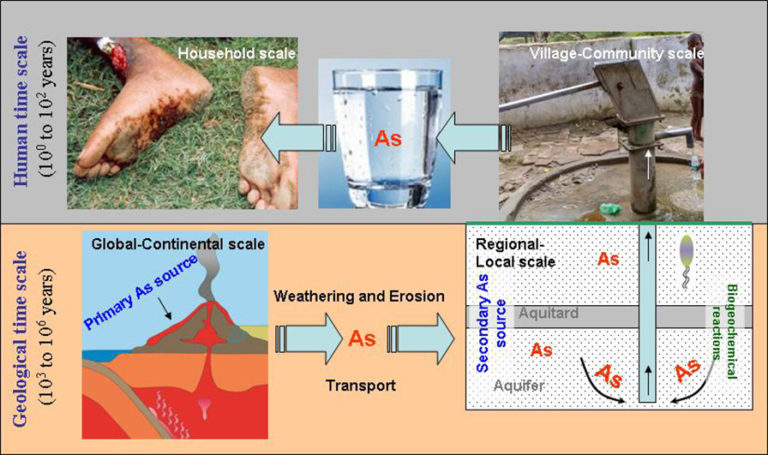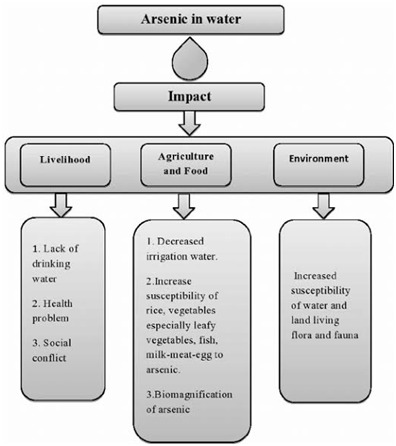Arsenic contamination in groundwater in the Ganga- Brahmaputra fluvial plains in India and Padma-Meghna fluvial plains in Bangladesh and its consequences to the human health have been reported as one of the world’s biggest natural groundwater calamities to the mankind. In India, seven states namely- West Bengal, Jharkhand, Bihar, Uttar Pradesh in the flood plain of the Ganga River; Assam and Manipur in the flood plain of the Brahamaputra and Imphal rivers and Rajnandgaon village in Chhattisgarh state have so far been reported affected by Arsenic contamination in groundwater above the permissible limit of 10 μg/L. People in these affected states have chronically been exposed to drinking Arsenic contaminated hand tube-wells water. With every new survey, more Arsenic affected villages and people suffering from Arsenic related diseases are being reported, and the issues are getting complicated by a number of unknown factors. These fluvial plains represent Holocene aquifers of recent alluvial sediments and have the routes originated from the Himalayan region. Arsenic groundwater contamination has far-reaching consequences including its ingestion through food chain which are in the form of social disorders, health hazards and socio-economic dissolution besides its sprawling with movement, and exploitation of groundwater. Arsenic contamination is understood to be of geogenic origin released from soil under conditions conducive to dissolution of Arsenic from solid phase on soil grains to liquid phase in water, and percolation of fertilizer residues might have played a modifying role in its further exaggeration. There are a number of hypotheses about the source of Arsenic and probable reasons of occurrence in groundwater.

Over the last 25 years since the groundwater Arsenic contamination was first surfaced in the year 1983, a number of restorative and precautionary measures coupled with action plans focusing mainly on detailed investigations to understand the physiochemical process and mechanism, alternate arrangement to supply Arsenic free water to the affected populace and development of devices for Arsenic removal and their implementation at the field, etc. have been initiated mainly in West Bengal while in other States, they are meager. Despite a number of corrective and precautionary measures, the spread of Arsenic contamination in groundwater continued to grow and more new areas were added to the list of contaminated area. The problem resolving issues, thus, seemed to be partial and inadequate, which need to be strengthened by strategic scientific backing. Numerous investigators have come out with a number of findings, and alternatives propositions, which varied from identification of shortfalls to success stories. The present state of affairs of the Arsenic menace in India demand a systematic translation of success stories of one place/region to another, and overcoming the shortfalls by conceiving R&D studies in areas wherever deemed fit. Advancement in understanding of geochemical and mobilization processes, devising satisfactory Arsenic removal filters, identification of shortfalls in operation and maintenance of Arsenic removal techniques, delineation of risk free deeper aquifers as an alternate source of groundwater, developing surface water based water supply schemes in many Arsenic affected areas, success stories of community participation in running Arsenic removal plants, etc. are some of the important achievements, which could help derive a comprehensive framework of activities leading to mitigation and remediation of the issues emerging out of Arsenic menace. The paper is thus aimed at highlighting the state-of-affairs of Arsenic groundwater contamination in India along with narration of various corrective and precautionary measures taken up so far by different states and success achieved and failure experienced. The paper would also discuss the gaps and areas in which further actions are to be taken up and their scope.

Arsenic (As) is introduced into soil and groundwater during weathering of rocks and minerals followed by subsequent leaching and runoff. It can also be introduced into soil and groundwater from anthropogenic sources. Many factors control arsenic concentration and transport in groundwater, which include: Red-ox potential (Eh), adsorption/ desorption, precipitation/dissolution, Arsenic speciation, pH, presence and concentration of competing ions, biological transformation, etc. The adsorption and desorption reactions, arsenic species, Eh, pH and solid-phase dissolutions and precipitations may vary from aquifer to aquifer that depend upon the geological settings, geo-chemistry and geo-environmental conditions of an aquifer. Therefore, rigorous geochemical investigation for adequate understanding of arsenic geochemistry under different hydrogeological and geo-environmental conditions of aquifers is essentially required for evolving sustainable solutions.
In India, since the groundwater arsenic contamination was first surfaced from West-Bengal in 1983, a number of other States, namely; Jharkhand, Bihar, Uttar Pradesh in flood plain of the Ganga River; Assam and Manipur in flood plain of the Brahamaputra and Imphal rivers, and Rajnandgaon village in Chhattisgarh state have chronically been exposed to drinking arsenic contaminated hand tube-wells water above permissible limit of 50 μg/L. Many more North-Eastern Hill States in the flood plains are also suspected to have the possibility of arsenic in groundwater. Even with every additional survey, new arsenic affected villages and people suffering from arsenic related diseases are being reported. All the arsenic affected river plains have the river routes originated from the Himalayan region. Whether or not the source material has any bearing on the outcrops is a matter of research, however, over the years, the problem of groundwater arsenic contamination has been complicated, to a large variability at both the local and regional scale, by a number of unknown factors.

Arsenic groundwater contamination has far-reaching consequences including its ingestion through food chain, which are in the form of social disorders, health hazards and socioeconomic dissolution besides its sprawling with movement, and exploitation of groundwater. The food crops grown using arsenic contaminated water are sold off to other places, including uncontaminated regions where the inhabitants may consume arsenic from the contaminated food. This may give rise to a new danger.
In order to combat arsenic menace, a number of counteractive measures, steps and research studies have been initiated and put into practice mainly in West Bengal, while in other States, they are meager. The measures and steps have mainly been focused towards providing arsenic free drinking water to the entire population in the arsenic infested areas by arrangement of alternate freshwater sources and by treating contaminated groundwater using arsenic removal techniques. During the last three decades, substantial amount of R & D work has been done to enrich knowledge in respect of the following:
- The source and cause of Arsenic contamination in groundwater.
- Extent and magnitude of the contamination in groundwater.
- Mechanism of dissolution of Arsenic from soil to groundwater.
- Impact on Community Health: Diagnosis of sickness and symptoms.
- Development of technologies for removal of arsenic from groundwater.
- Analytical techniques for detecting arsenic from groundwater.

How far the counteractive measures and steps, initiated by the Government, are effective in terms of restoring, resolving and remediation of the problem, attaining sustainability to combat the menace, understanding the physical processes, etc. needs a critical appraisal to ensure its effective implementation in other arsenic contaminated areas. Needless to state that a comprehensive understanding of the above aspects would go a long way in developing immediate, interim and long term strategy and to address the problem. However, the concerns are:
- Whether available knowledge, understanding and technologies are adequate to achieve sustainable solution of the arsenic remedy for different hydro geological setups?
- As to how to proceed for envisaging alternate feasible solutions?
- Whether ex-situ removal techniques are feasible solution, and how it can be made more cost effective, eco-friendly and socially acceptable?
- What are the feasible solutions for in-situ remedy of arsenic from contaminated aquifers? etc. After all, arsenic safe groundwater is to be made available to meet demands for both domestic and agricultural requirement in arsenic affected and arsenic vulnerable areas.
The present paper thus deals mainly with:
- Up to date status of arsenic menace in India,
- State-of-the-art of scientific knowledgebase, understanding and technologies available from both national & international perspectives,
- Technologies in place,
- Preventive and corrective measures taken so far and results thereof,
- Shortcomings, and possibility of employing success stories of one place to another region,
- Further work to be undertaken.

Occurrences of Arsenic in Groundwater
Several studies suggested that the groundwater arsenic contamination is mostly restricted to the alluvial aquifers of the Ganges delta comprising sediments carried from the sulphide-rich mineralized areas of Bihar and elsewhere surrounding the basin of deposition (Bhattacharya et al., 1997; Das et al., 1995). However, recent studies indicated that the vast tract of Indo-Gangetic alluvium extending further to the west and the Brahmaputra alluvium have elevated concentrations of arsenic in wells placed in the late Quaternary and Holocene aquifers. Arsenic released during the weathering of sulphide minerals is generally adsorbed onto the surface of iron oxy-hydroxides that precipitated under oxidizing conditions normally prevailing during the deposition of the Holocene sediments. However, redox processes in the sediments triggered the reductive dissolution of iron oxides that transferred substantial amounts of arsenic in aqueous phases through biogeochemical interactions (Amaya, 2002; Smedley and Kinniburgh, 2002). Arsenic-containing groundwater in Ganga–Brahmaputra River basin is hosted by the sediments deposited by the rivers during the late Quaternary or Holocene age (< 12 thousand years). Lithology of those late Quaternary sediments includes sands, silt and clay. Mineralogical composition of those sediments consists of quartz, feldspars, illite and kaolinite and the fine-grained over bank facies are rich in organic matter (Nickson et al., 1998; Ahmed, 1999; Datta and Subramanian, 1998; Sikdar and Banerjee 2003). There is a thick layer of newer alluvium containing sand, silt and clay, which spread out by numerous rivers that originate from the Himalayas both in the north and northeast. Most environmental arsenic problems, recognized so far, are the result of mobilization under natural conditions. Thus, the occurrence of arsenic in groundwater in the BDP and Gangetic plains has been recognized as of geological origin with spread out resulting from the mobilization under natural hydro-geologic conditions.
“Collect the water from rain to live without pain.”
Vardhman Envirotech,
India’s Passionate Rainwater Company
